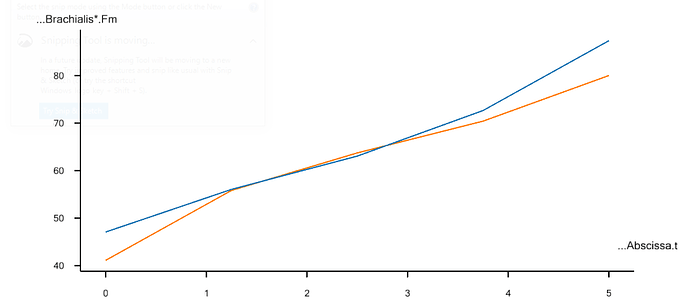Hi,
I want to use the Body Model to configure for only the shoulder portion. For that I have turned both legs and left arm off. Then , turn the shoulder rhythm on and define the right arm muscles to 3E Hill Type. Then, in the Mannequin.any, changed the elbow flexion angle to 90 degree. So, I want to estimate the muscle forces responsible for holding the elbow in that position.
Is this the procedure or do I need to do anything?
Hi Kamal,
That sounds about right. If you are using 3E Hill Type muscles, you should also run the calibration study before inverse dynamics analysis.
Best regards
Dave
Hi Dave,
Thank you for the reply. I am currently using the standing model from AMR 2.0. I turned off the left arm (with its muscle) and both leg muscles to have only the right arm. I want to estimate the muscle forces when an arm is held in 90-degree flexion.
For that, I have set the initial position of elbow flexion to 90. Then run a inverse dynamic, but I don't know why I am not getting results as expected. The biceps force is very small, as are other muscle forces too (the biceps is 11 N and the brachialis is 23 N).
I don't know what the problem is. Do I need to do anything with the default JointAndDriver. any file?
Thank You
Best Regards
Kamal
Hi Kamal,
When you drive the angle of the elbow to 90 deg, please make sure the driver reaction has been switched off... Reaction.Type={Off} this could possibly explain what you see?
Best regards
Søren
Hi Soren,
Thank you for the reply.
Currently, I am using FreePostureFullBodyStatic.Main.any from AMS 7.1 and AMMR 2.0. I have used the 3E_HILL muscle type for the right arm and ran a calibration followed by InverseDynamics.
Yes, the driver's reactions are OFF in the RighArmDrivers.any.
I suppose the elbow flexion results were reasonable. But when I try to have an elbow extension from an initial elbow flexion position of 120 degrees by setting jointVel to -18 and running the simulation for 5 seconds, I see no forces at all from the triceps muscles (even in some other postures, there is no contribution from the triceps and some other muscles).
What could be the possible reason for the triceps not working in a motion where we definitely expect them to be working for the motion specified?
Thank You
Hi Kamal
If you have the upper arm vertical and extend elbow from 120 to 180 i would not expect triceps to do a lot, gravity will pull the arm downwards without much need for triceps. If you want to see triceps in more action try to add some external load to the model e.g. in the hand. using AnyForce3D
Best regards
Søren
Hi Sore,
I did try with the AnyForce3D (load), but I don't know why I still had no luck. I provided the initial GHFlexion of 20 degrees and elbow flexion of 120 degrees, then had -10 deg/s of elbow flexion velocity for 5 seconds of the study period.
I was wondering if the shoulder rhythm had any problems in the previous version, (AMMR 2.0). When I studied the version update manual, I saw that the latest version utilizes elevation planes and elevation angles for the shoulder flexion and abduction motions. While the current version has GHFlexion and GHAbduction to define the GH motion.
I have attached some of the pictures from the work I am doing.
Thanks for the help.
Regards,
Kamal



Hi Kamal,
The load you apply is downwards y in global coordinates, this load can not and should not be carried by triceps muscles, it will be carried by muscles like biceps etc.
To see triceps action try to flip the sign on the load.
Best regards
Søren
Hi Søren,
It worked. Thank you.
I have two more questions, about which I am confused:
-
Since the triceps muscle crosses the GH joint with its origin in the Scapula, shouldn't there be some force in the triceps too when there is a change in position of the GH joint that causes the rotation or translation of the scapula? My idea is that whenever a muscle crosses more than one joint, that muscle does have some forces, if not all, to balance both joints.
-
Is there any difference in calculating the muscle force for some static posture compared to the motion of the arm?
Once again, thank you for the prompt replies and clarifying my doubts.
Best regards
Kamal
Hi Soren,
Just ignore my previous query or questions.
I was wondering why there is no force in the Triceps muscles when I hold my elbow in 90-degree flexion and run the simulation for that static posture.
Thank you.
Regards,
Kamal
This topic was automatically closed 125 days after the last reply. New replies are no longer allowed.

